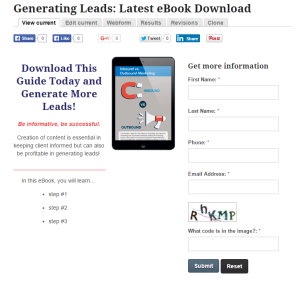Who here loves using webforms on their website?

Yep, we all love webforms. Webforms are a handy feature to have especially when it comes to signing people up to newsletters, collecting prospective client information, RSVPing people for events, scheduling important meetings and much, much more!

Despite the simplicity of creating a webform, the real concern here is whether you know what makes an effective webform or not. Notice, I emphasized the word "effective". It's one thing to know how to create a webform but another to create a great one that actually does the job of enticing people to fill it out.
The objective of this article is to help you maximize your potential of generating more leads through effective webforms. To do so, we must sift out the bad practices you're using to create them. So here's the top 3 mistakes advisors make when creating their webforms.
#1. A webform is NOT a survey
Many advisors make the mistake of confusing webforms as surveys. Surveys are designed to ask respondents many questions. Majority of these take the form of multiple choice questions too; something that your webforms should definitely avoid to be.
Your webforms should strive to be quick, short and overall, non-opinionated. You don't want people looking at it and going like,"well this will take too long to fill so I won't even bother." Remember, people arrive at a website (any website) hoping to find what they're looking for in a jiffy. If something takes too long to do or obtain, you can bet they're out of there before you can say "wait!"

If you would like someone to take a survey, consider using TypeForm to do the trick.
#2. Too many fields to fill
Touching on the previous point, try limiting the number of fields in your webforms. Nothing is worse than seeing a long list of fields that require the user to fill. Only ask for information that is absolutely necessary to retrieve. Most of the time a name and email address will suffice. So avoid asking for their job titles, company and mobile number.

Alternatively, you may ask for all the information you want, but allow for people to have the option of filling in these fields.
#3. Don't ask for personal information
This is an important point to mention since the webforms on the AW dashboard are not encrypted. This means that any sensitive information that your prospective clients include is not protected or secured. So, please, avoid including fields that ask for social security numbers and the like.
Key Take Aways
If there was one thing from this article to take away, it would be this:
Don't let a poorly made webform ruin your lead generation potential.
Building a good webform is a task that's often overlooked because we tend to think, "well if I just include a webform, people will want to fill it out." The cold, hard truth, however, is this isn't always the case, especially if your webform has too many fields or functions like a typical survey.
So the next time you go about making a webform, remember, keep it short and sweet.
If you have any questions submit a ticket to support. Also, tweet and follow us on Twitter!






.png)

